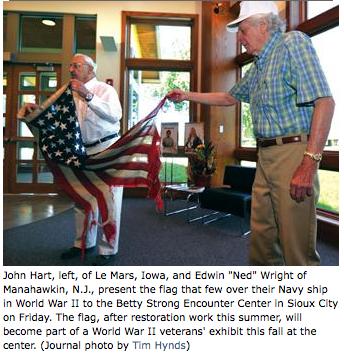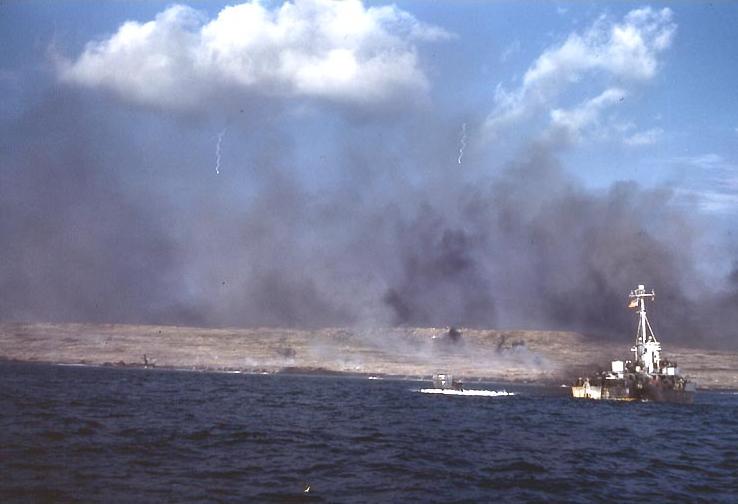 After a few weeks of interesting diversions and side-trips; I have decided to get back to Vince Lombardi FbF.
After a few weeks of interesting diversions and side-trips; I have decided to get back to Vince Lombardi FbF.Late last month there was an interesting gathering in Iowa that highlights a few things dear to my heart. First, there were so many Sailor in so many "less sexy" ships that made such a huge difference in WWII. Secondly, in an age of much slower communication and where engineering was done by hand, not CAD, where leaders led and let their subordinates demonstrate their capability, leaders could not and did not micromanage patronize about small things - we did achieved great things with lighting speed when it came to building ships to meet a specific need. Thirdly, we named and classified our ships by logic, not buzzwords.
By now, all should fully understand that those who designed the Littoral Combat Ship "LCS" were brilliant ignoramuses and their fellow travelers who named it either did not know or care that the US Navy already has a series of ships known as LCS, as in "Landing Craft Support" (AKA "Mighty Midgets" or "Mighty Mites") and arrogantly decided to make a non-Amphib start with "L" just so they could get the late 90s early 00s buzzword in their new budget line - and name their new toy LCS "LCS-1" - what an insult to our Navy and its Sailors.
However, this isn't about my LCS hobby-horse; let us honor to such men as John Hart, left, of Le Mars, Iowa, and Edwin "Ned" Wright of Manahawkin, N.J who you see on the right, as representatives of the men who served on the LCS from WWII to Vietnam.
Let's educate; what were the LCS?
Displacement: 250 long tons (254 t)What did the WWII LCS bring to the fight?
Length:------158 ft 6 in (48.3 m)
Beam:--------23 ft 3 in (7.1 m)
Draft:-------5 ft 10 in (1.8 m) (aft, loaded)
Propulsion:--eight Gray Marine diesel engines, twin screws
Speed:-------16.5 knots (30.5 km/h)
Range:-------5500 miles
Complement:--3–6 officers, 55–68 men
Armament:----single 3"50, twin 40 mm or single 40 mm bow gun; 2 twin 40 mm deck guns (one forward, one aft); 4 20 mm cannons; 4 .50 cal (12.7 mm) machine guns; ten MK7 rocket launchers.
Armor:-------10-lb. STS splinter shields
The Battle of Tarawa showed a gap in Navy resources for close in support of landing troops. The time interval between the end of shelling from the large ships and the arrival of the landing craft on the beach allowed the defenders to regroup. The Landing Craft Support was designed to fill this void.The gentlemen above were from LCS-92, and here is a short history of the ship by one of its Commanding Officers, Lt. Joseph J. Cardamone.
The first Landing Craft Support ships arrived in the Pacific Theater in time for the landings at Iwo Jima.
After providing close in support during the landings at Okinawa, many Landing Craft Support ships were placed on the radar picket stations as anti-aircraft platforms. When not on a picket stations, the ship would create smoke to hide the fleet at anchor and perform "skunk patrol" screening for suicide boats.
In the Borneo Campaign, Landing Craft Support was used in landings in Tarakan and Balikpapan.
(in Okinawa) Kamikaze planes sank two LCS(L)(3)s while they were on radar picket duty to provide anti-aircraft support for destroyers trying to stop enemy planes from reaching the main fleet. On April 12, 1945, while at Radar Picket Station 1 north of Okinawa, LCS(L)(3) 33 shot down one kamikaze plane, dodged a second one that took off the ship’s radio antenna, but sank after being struck by a third one. On April 22 at Radar Picket Station 14 northwest of Okinawa, LCS(L)(3) 15 sank within three minutes after one kamikaze plane in a group of 37 planes crashed into the ship with a bomb carried by the plane exploding soon after. The attack killed 15 men and wounded 11 men. In addition to the two LCS(L)(3)s sunk, 11 others were damaged in kamikaze attacks during the Battle of Okinawa.
Japanese shinyo explosive motorboats sank more LCS(L)(3)s than the two sank by kamikaze planes. About 30 shinyo motorboats attacked LCS(L)(3)s in Mariveles Harbor in the Philippines on February 16, 1945, but the book provides no details on this attack. The explosive motorboats sank LCS(L)(3)s 7, 26, and 49 and severely damaged LCS(L)(3) 27.
Although destroyers provided the primary firepower at radar picket stations around Okinawa, LCS(L)(3) guns also shot down many incoming kamikaze planes. For example, at Radar Picket Station 1 on April 16, 1945, LCS(L)(3) 51 shot down six attacking planes and helped fight fires on the destroyer Laffey (DD 724) after that ship had been hit by several kamikaze planes. LCS(L)(3) 51 received a Presidential Unit Citation for her actions.
During the Battle of Okinawa, several LCS(L)(3)s rescued survivors after kamikaze attacks that sank or heavily damaged other ships. For example, on June 10, 1945, after the destroyer William D. Porter (DD 579) was hit by a kamikaze plane and started to sink, LCS(L)(3)s tried to tow the ship to port but failed. The destroyer, which sank about three hours after the kamikaze plane crash, lost no men due to the superb rescue work of the LCS(L)(3)s. The photo at the bottom of this page shows LCS(L)(3) 122 crowded at her bow with survivors from William D. Porter shortly before she sank. Even though William D. Porter lost no men, LCS(L)(3) 122 was hit the following day by a kamikaze plane and lost 11 men with the number of wounded totaling 29.
It was on the swift-flowing Willamette River at Portland, Oregon that the USS LCS 92 was commissioned on January 8th, 1945. Like the ship itself, the ceremony was simple, compact and diminutive. A superficial but extensive inspection convinced the Captain, the five junior officers and the 65 men who made up the crew that the ship’s builders, Commercial Iron Works, had turned out a good, trim fighting ship.And yes, I ask you to note that our grandfathers Commanded as a LT what today's Navy calls a CDR Command. Just saying...though that isn't fair in that at ~3,000 ton full-load displacement, a modern LCS is 500 tons heaver than the ~2,500 full-load displacement of a WWII era Fletcher Class Destroyer - another topic I will avoid for now.
Ten furious days of outfitting, checking and requisitioning followed. On January 16th the LCS 92 was deemed “in all respects ready for sea”. All lines were cast off and she slipped slowly down the Willamette, through the famed Columbia River and out into the Pacific Ocean.
San Diego, California was the destination, and it was reached on the 23rd of January after a voyage that was full of surprises, some pleasant and some otherwise. Then came a six-week shakedown and training period, a period in which flaws were eliminated from both men and ship.On March 3rd, 1945, the shakedown program was abruptly ended, and the LCS 92 left the United States Continental limits for Pearl Harbor, arriving there March 12th. A new training schedule was begun at Pearl Harbor. It was called “advanced training” and lasted for a full month.
From Pearl Harbor on the 13th of April the ship sailed to Eniwetok. The anchor was dropped in this Marshall Island stronghold on the 24th of April, 1945.
Some minor repairs, a full supply of provisions, fuel and water and the “92” was ready for another trip. Four days later, April 28th, the ship departed from Eniwetok. The next stop was made at Saipan in the Marianas Group on the 3rd of May. There was just a two-day stopover here and the LCS 92 was again underway, this time for Okinawa, performing convoy duty enroute.
After a safe, uneventful voyage Okinawa was reached May 10th, 1945. The “92” really came in contact with the war for the first time. As the anchor was dropped, the screaming of shells from battleships, cruisers and destroyers could be heard overhead. It was one of the many bombardments the Japs were subjected to. Between the date of arrival and the date of departure from Okinawa, July 22nd, the ship was at General Quarters scores of times. Often “bogeys” were reported nearby several times in a single day. The “Kamikaze Kids” were on a rampage. Most of them were downed but the small percentage that did get through produced severe naval casualties.
On the 25th of May the ship left Okinawa for its first Picket Line duty at Station number 9. Now began ten endless days of patrolling deep in enemy waters. It was on this Radar Picket station on the 29th of May that an unusually intense attack occurred. Hardly had the General Quarters buzzer ceased sounding than a “Zeke” was seen diving across the fantail. The gunners were “on target” immediately and a moment later the plane disintegrated.
Back in Okinawa a few days later the ship was assigned to anti-suicide boat duty and given several smoke screen assignments. Then the LCS 92 returned to picket duty, this time on notorious Radar Picket station 16A, “Mainstreet” for the Kamikazes. At this station there were even more alerts, more enemy planes overhead and more sleepless nights.
Upon returning from this duty the “92” was stationed at Ie Shima, furnishing smoke screens at night and anti-aircraft protection by day. The routine was occasionally broken by orders to check a certain area for floating mines or to conduct a search for “splashed” allied flyiers. One day a flyer, who had bailed out of his wrecked Black Widow after a mission over Kyushu, was picked up.
Finally it was time to leave Okinawa and on the 22nd of July the anchor was housed and the ship got underway for the Philippine Islands, for rehabilitation and availability. Five days later the ship was anchored in San Pedro Bay near Leyte Gulf. Here a number of minor repairs were made, the ship was painted and the crew given some well-earned recreation. This routine continued until V-J day plus one, September 3rd, when the ship once more got underway. The destination was Tokyo, Japan as a part of the Third Fleet Occupational Forces. Here, in Tokyo Bay, the ship remained until 1 October, 1945.
The LCS 92 left Tokyo Bay in February 1946 and sailed to the United States via Guam, Eniwetok and Pearl Harbor, arriving in San Francisco on 1 April 1946, a beautiful, sunny morning. The Golden Gate bridge was a sight to behold. The ship was then placed in the Reserve Fleet at Astoria, Oregon in the summer of 1946. In 1951, the 92 was stricken from the Naval Register and scrapped.
Finally, we are lucky - the last operational one is returning from Thailand.
From Pattaya Mail (Vol. XV No. 37 Friday September 14- September 20, 2007) "HTMS Nakha set off on her final voyage home on September 2, heading for the Mare Island Naval Shipyard at Vallejo City in the United States where she will become part of a museum of historic ships".Not bad for a ship designed and built in months.
More photos worth your time here and like the color one of Iwo Jima below here. There is also an excellent book on the ships, if you are inclined, available at the link.

At about the 2:30 point below, you can see the WWII LCS at ~25yr mark in Vietnam.
UPDATE: Great LCS write by by Eagle1 last NOV.









No comments:
Post a Comment